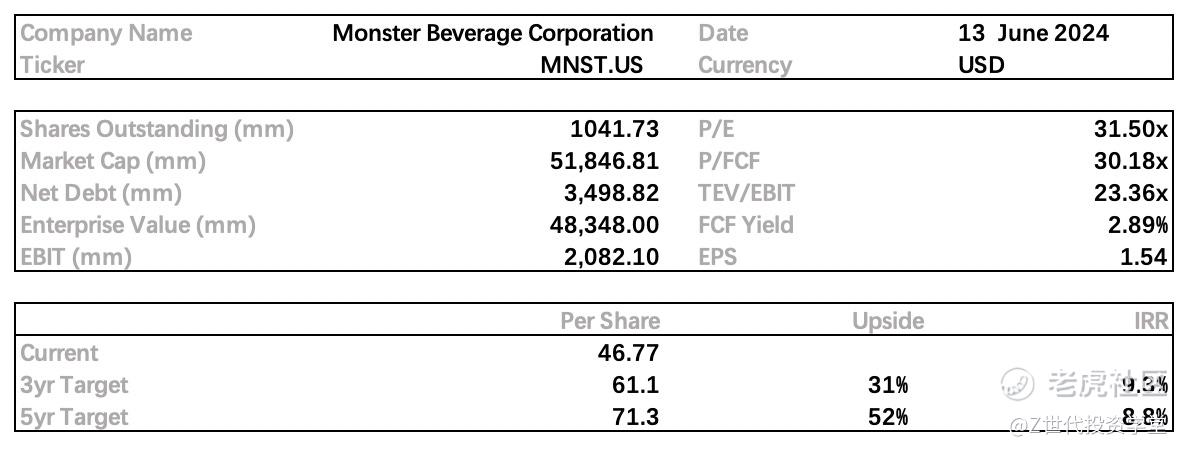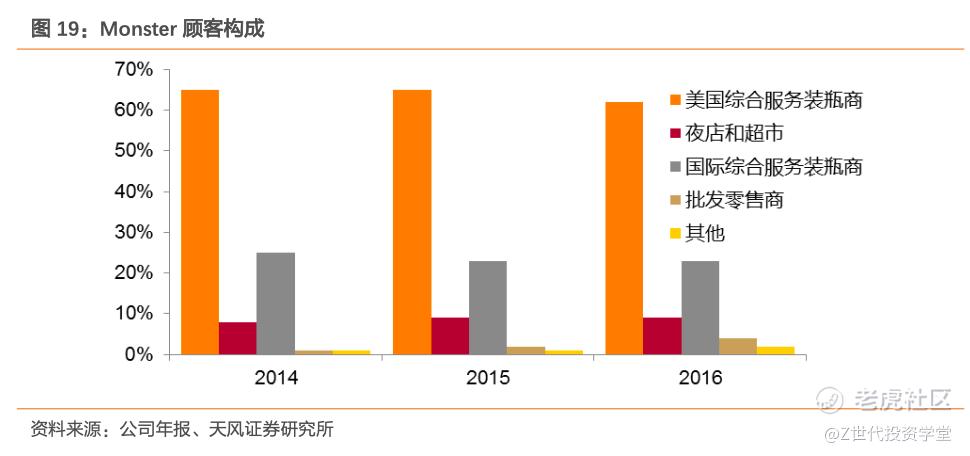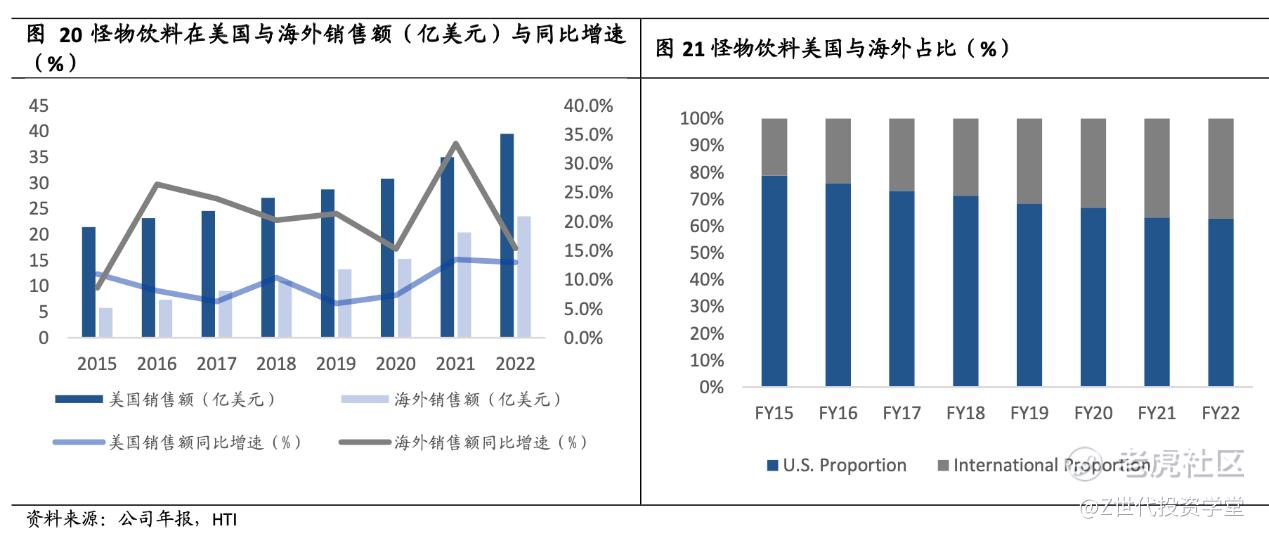1. Company Overview:
Monster Beverage Corporation, formerly known as Hansen, is a Holding Company headquartered in Crona, California. It develops, promotes, sells, and distributes energy drinks through its subsidiaries. In 2002, it launched the Monster energy drink series and began transitioning from juice soda to energy drinks.
The revenue streams are primarily divided into four operating and reportable segments: 1) Monster Energy Drink (91.81%): primarily sells ready-to-drink packaged energy drinks (RTD) to bottlers and full-service beverage distributors. 2) Strategic Brands (5.27%): primarily generates net operating income from the sale of concentrate or beverage base to authorized bottled and canned partners for the brand series eg, NOS, Throttlee, etc., which were exchanged from Coca-Cola . 3) Alcohol Brands (2.58%): primarily generate revenue from the sale of barrel beer, ready-to-drink canned beer, hard fruit alcoholic beverages, and flavored malt beverages to beer distributors in the US. 4) Other (0.33%): Covers non-energy drinks, such as tea drinks, lemonade, and other soft drinks.
2. Company History
1) 1930-2001 Start-up period:
Operating juice and soda water business.
In 1997, following Red Bull, Monster launched the 8.3-ounce carbonated energy drink Hansen's Energy Drink, which ultimately failed.
2)2002-2007 Transition Period:
As a pioneer, Red Bull has completed consumer education about energy beverages, and the energy drink market has developed rapidly. In 2002, the company launched Monster Energy Drink, which was well received, and has since deeply cultivated the energy drink track.
-
Pricing strategy: counter positioning on pricing strategy-'cost-effective strategy', doubling the capacity at the same price. The company launched a 16-ounce product with a price similar to Red Bull's 8.4-ounce product.
-
Promotion strategy: At the beginning of the 21st century, young people in the US pursued individuality. The company used packaging that was different from traditional drinks such as Coca-Cola and Pepsi. It used a bold and avant-garde (dark color) image to match the marketing of high-intensity activities such as extreme sports and car races, anchoring the younger generation of consumer groups.
-
Channel strategy: In 2006, Monster signed a distribution agreement with Budweiser, the largest beer company in the US.
3)2008-2014 Globalization Transition Period:
In response to the 2008 US financial crisis, Q4 partnered with Coca-Cola's distribution network to expand the global market, increasing convenience store coverage to 92%. At the same time, Red Bull vigorously expanded its global distribution network. In contrast, Red Bull established the "Red Bull North America Distribution Company" to be fully responsible for Red Bull's sales in North America.
Signed a distribution agreement with Asahi Beer in Japan in 2011, responsible for exclusively distributing Monster products in Japan.
In January 2012, the company was officially renamed Monster Beverage Corporation.
4)2015-2023 Maturity period:
In 2015, Coca-Cola invested and obtained a 16.7% equity stake in the company for $2.17 billion. As of the end of 2023, Coca-Cola holds 19.5% of the shares and is the largest shareholder.
Completed brand exchange with Coca-Cola, obtained the energy drink brand owned by Coca-Cola, and entered the Coca-Cola bottling system at the same time. The company has transferred most of its bottling and distribution business to Coca-Cola bottlers.
On April 1, 2016, the company completed the acquisition of its long-term partner, American Fruits & Flavors (AFF), for $690 million. The integration of major flavoring suppliers into the company's system will provide better support for product flavor development and uniqueness retention.
Acquired CANARCHY in 2022, testing the beer industry.
Acquired VITAL PHARMACEUTICALS in 2023 to further enrich the product matrix with BANG ENERGY.
Implement pricing actions from 2022 to 2023, increase prices, reduce promotional discounts, and have a positive impact on gross profit in 2023.
3. Industry Overview:
3.1 What are energy drinks?
Energy drinks are beverages that contain energy ingredients and add additional nutrients or specific ingredients such as taurine, caffeine, guarana, ginseng, etc. These drinks are designed to supplement the body with energy or accelerate the release and absorption of energy.
Energy drinks not only have the thirst-quenching and hydrating functions of traditional packaged drinks, but can also quickly supplement the energy components needed by the human body. Compared with traditional drinks, they can enhance the functions of nerves, muscles, and the heart, providing health benefits such as refreshing the mind, restoring physical strength, and enhancing immunity. In addition, energy drinks are usually designed to be portable and easy to consume, suitable for athletes, professionals who work long hours, and people who need extra energy.
3.2 Alternatives to caffeine consumption habits:
Western consumers are accustomed to drinking addictive beverages and have a considerable dependence on caffeine. Compared with traditional coffee and tea, functional beverages not only meet the expectations of modern consumers for functional needs, but also keep pace with the times, closely combining products with culture and sports. Through rich marketing strategies and brand stories, they have successfully attracted advocates of healthy lifestyles and sports enthusiasts, effectively conveying brand concepts through sports and health. This combination strengthens consumers' dependence on functional beverages and develops strong stickiness, further increasing their brand loyalty.
1) Caffeine:
Central nervous system stimulants drive away drowsiness, but can easily cause irritability, anxiety, insomnia, etc
85% of Americans drink caffeinated beverages at least once a day, with an average daily consumption of 165 milligrams of caffeine per person. Energy drinks have a caffeine content of 0.3mg/ml.
2) Taurine:
Promote nutrient metabolism, improve human antioxidant capacity, have calming and attention-enhancing effects.
3.3 Market size, growth rate, and industry trends
According to Euromonitor, the size of the US energy drink market was $17 billion in 2019, and by 2023, this market size will increase to $23 billion, an increase of 35.3% from pre-epidemic levels. Energy drinks account for 9.2% of the entire beverage market, ranking fourth in the soft drink category. Compared with mature carbonated drinks, packaged water, and juice, energy drinks still have huge development potential.
Functional drinks are a high-quality track in the beverage market, thanks to the deep coffee culture abroad. Many people are accustomed to consuming caffeine every day to stay awake. Therefore, functional drinks are not only highly addictive, but also have a high Re-purchase Rate. Although their single bottle price is higher than that of ordinary carbonated drinks, it is lower than that of coffee. This pricing strategy and consumption frequency have jointly promoted the expansion of its market size.
4. Business Model:
Monster primarily produces ready-to-drink energy drink RTDs (not directly manufactured goods) through contract manufacturers, and then sells them directly to end consumers through an extensive distribution network of bottlers and full-service distributions, including retail and wholesale channels.
Value positioning: "unleash the beast and release wildness"
-
It fits the consumption demands of young people who pursue individuality, vitality, and freedom.
-
The logo "Claw" and the name "Monster" both represent wildness, integrating fashion excitement, the pursuit of individuality, and the courage to challenge themselves into their corporate values.
Customer group :
young people aged 18-34, targeting young people who pursue excitement and vitality (this group is also the main consumer of energy drinks)
-
The main consumers of Red Bull functional drinks are tired people, and they occupied 80% of the market share in 2000. Monster (formerly Hansen) needs to differentiate its target audience by targeting young people who are energetic, exercise regularly, have good consumption ability, and have a high acceptance of US functional drinks. The two have different consumption scenarios and face different customer groups.
Key business
-
Monster series - selling bottled RTD
Distribution Channels/Partners :
Often work with local beverage companies or large beverage distributors in different markets to optimize their distribution network and market penetration rate. Mainly distributed through contract manufacturers, bottlers, full-service distributors, retailers, wholesalers
In the Monster beverage segment, the company primarily sells finished products (RTD, Ready to Drink) to bottlers and full-service distributors, and in some cases, directly to grocery stores, wholesalers, nightclubs, supermarkets, convenience stores, and catering channels.
4.1 Source of income : contribution by operating segment and region
1)Sales: In 2023, Monster Energy ® Drinks segment contributed the majority of sales, accounting for 91.8%. Ready-to-drink packaging is the key business, not concentrates.
-
Net sales in 2023 : 7.14 billion USD;
-
External sales (outside the US) : $2.71 billion, approximately 38% of total sales
The international market has gradually become the main driving force for revenue growth. With the expansion of energy drinks in overseas markets, the growth rate of overseas markets is significantly higher than that of the US market. The proportion of overseas markets in global total revenue continues to increase, making overseas revenue account for nearly 40% of global total revenue in 2022, compared to only about 21% in 2015.
Sales revenue and proportion of operating sectors:
*Do note that all of this is for information only and should not be taken as investment advice. If you should choose to invest in any of the stocks, you do so at your own risk.






精彩评论